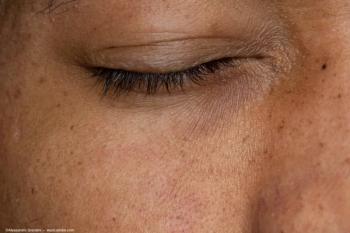
Post hoc analysis of GATHER1 and GATHER2 data
Key Takeaways
- Ellipsoidal zone (EZ) integrity is a potential biomarker for predicting geographic atrophy (GA) progression rates, facilitating early intervention to preserve photoreceptors.
- GATHER1 and GATHER2 trials showed that fast GA progressors had significantly greater baseline EZ degradation compared to slow progressors.
New analysis reveals the ellipsoidal zone's role in predicting geographic atrophy progression, enabling timely interventions to protect photoreceptors.
A post hoc analysis of the GATHER1 and GATHER2 data suggested that the ellipsoidal zone (EZ) may hold the key to identifying patients experiencing fast and slow progression of
The researchers reported that the GATHER1 and GATHER2 trials found that most sham-treated eyes with relatively slow or fast GA growth rates during the initial 6-month period tended to continue to progress at the same pace during the subsequent follow-up period.1 However, they pointed out, it was difficult to predict the future GA growth rates in eyes with a moderate growth rate.1
Previous studies have reported that the EZ integrity was associated with the GA growth rate and is a biomarker for photoreceptor health.2-4
The phase 23 GATHER1 (NCT02686658) and phase 3 GATHER2 (NCT04435366) studies were multicenter, randomized, double-masked, sham-controlled trials that examined the efficacy and safety of avacincaptad pegol 2 mg (Astellas Pharma, Inc.) in patients with GA that did not involve the foveal center.5,6
In this post hoc analysis, the data from the trials was pooled, and the sham-treated eyes were classified into four quartiles based on the growth rate of GA during the first 6-month period. The quartiles were defined as follows: quartile 1, very slow; quartiles 2/3, moderate; and quartile 4, very fast. The changes during months 6 to 18 then were divided into quartiles, ie, quartile 1, “slow-lane” switchers, and quartile 4, “fast-lane” switchers.
The following parameters of the EZ integrity at baseline were analyzed: partial EZ attenuation/degradation, defined as the percentage of the macular cute with an EZ-retinal pigment epithelial (RPE) thickness of 20 microns or less; the total EZ attenuation/loss, defined as the percentage of the macular cube with an EZ-RPE thickness of 0 microns; the total EZ-GA gap, defined as the percentage of the macular cube with an EZ-RPE thickness of 0 microns minus the percentage of the macular cube with GA; the EZ/GA ratio, defined as the ratio of the total EZ attenuation to the GA area percentage; and the EZ-GA index, defined as the percentage of the macular cube with GA.
The analysis showed that the mean baseline partial rates of EZ attenuation/degradation in the slow-lane and fast-lane switchers were, respectively, 39.4% and 56.0% (p = 0.011). The respective mean baseline total EZ attenuation/loss rates were 24.8% and 35.8% (p = 0.021). For both of those parameters measured, the rate was 1.4 times greater among the fast-lane switchers.
Regarding the mean total EZ-GA gap, the respective percentages at baseline were 7.6% and 15.4% (p = 0.018). Regarding the mean EZ-GA ratio, the respective percentages at baseline were 1.6% and 3.5% (p = 0.19). For both parameters, the baseline changes were two or more times greater for the fast-lane switchers.
Finally, for the EZ-GA index, the respective percentages at baseline were 0.6% and 2.5% (p = 0.19). This represented a three times or greater change for the fast-lane switchers.
The investigators concluded, “The fast-lane switchers had greater baseline total EZ loss and partial EZ degradation than the slow-lane switchers, highlighting that compromised EZ integrity is associated with fast GA growth. This pooled post hoc analysis suggested that the measures of EZ integrity can be used to identify patients who may be at high risk of rapidly progressing GA and who may benefit from early intervention to preserve photoreceptor health.”
References
Jaffe GJ. Presented at Angiogenesis 2024. February 3, 2024
Abraham J, et al. Poster presented at ARVO 2024. May 5-9. Poster 5711-B0117.
Pfau M, von der Emde L, de Sisternes L, et al. Progression of photoreceptor degeneration in geographic atrophy secondary to age-related macular degeneration. JAMA Ophthalmol. 2020;138:1026-1034.
Sarici K, Abraham JR, Sevgi DD, et al. Risk classification for progression to subfoveal geographic atrophy in dry age-related macular degeneration using machine learning-enabled outer retinal feature extraction. Ophthalmic Surg Lasers Imaging Retina. 2022;53:31-39.
Jaffe GJ, Westby K, Csaky KG, et al. C5 inhibitor avacincaptad pegol for geographic atrophy due to age-related macular degeneration: a randomized pivotal phase 2/3 trial. Ophthalmology. 2021;128:576-586.
Khanani AM, Patel SS, Staurenghi G, et al. Efficacy and safety of avacincaptad pegol in patients with geographic atrophy (GATHER2): 12-month results from a randomized, double-masked, phase 3 trial. Lancet. 2023;402(10411):1449-1458.
Newsletter
Don’t miss out—get Ophthalmology Times updates on the latest clinical advancements and expert interviews, straight to your inbox.


















































.png)


